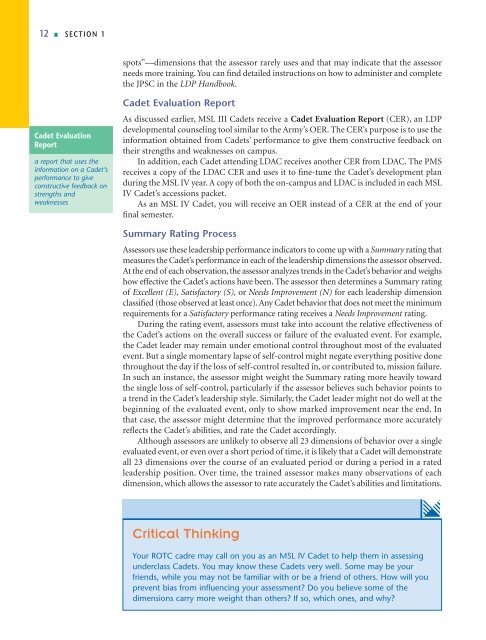using the leadership development program - UNC Charlotte Army ...
using the leadership development program - UNC Charlotte Army ...
using the leadership development program - UNC Charlotte Army ...
You also want an ePaper? Increase the reach of your titles
YUMPU automatically turns print PDFs into web optimized ePapers that Google loves.
12 ■ SECTION 1spots”—dimensions that <strong>the</strong> assessor rarely uses and that may indicate that <strong>the</strong> assessorneeds more training. You can find detailed instructions on how to administer and complete<strong>the</strong> JPSC in <strong>the</strong> LDP Handbook.Cadet EvaluationReporta report that uses <strong>the</strong>information on a Cadet’sperformance to giveconstructive feedback onstrengths andweaknessesCadet Evaluation ReportAs discussed earlier, MSL III Cadets receive a Cadet Evaluation Report (CER), an LDP<strong>development</strong>al counseling tool similar to <strong>the</strong> <strong>Army</strong>’s OER. The CER’s purpose is to use <strong>the</strong>information obtained from Cadets’ performance to give <strong>the</strong>m constructive feedback on<strong>the</strong>ir strengths and weaknesses on campus.In addition, each Cadet attending LDAC receives ano<strong>the</strong>r CER from LDAC. The PMSreceives a copy of <strong>the</strong> LDAC CER and uses it to fine-tune <strong>the</strong> Cadet’s <strong>development</strong> planduring <strong>the</strong> MSL IV year. A copy of both <strong>the</strong> on-campus and LDAC is included in each MSLIV Cadet’s accessions packet.As an MSL IV Cadet, you will receive an OER instead of a CER at <strong>the</strong> end of yourfinal semester.Summary Rating ProcessAssessors use <strong>the</strong>se <strong>leadership</strong> performance indicators to come up with a Summary rating thatmeasures <strong>the</strong> Cadet’s performance in each of <strong>the</strong> <strong>leadership</strong> dimensions <strong>the</strong> assessor observed.At <strong>the</strong> end of each observation, <strong>the</strong> assessor analyzes trends in <strong>the</strong> Cadet’s behavior and weighshow effective <strong>the</strong> Cadet’s actions have been. The assessor <strong>the</strong>n determines a Summary ratingof Excellent (E), Satisfactory (S), or Needs Improvement (N) for each <strong>leadership</strong> dimensionclassified (those observed at least once). Any Cadet behavior that does not meet <strong>the</strong> minimumrequirements for a Satisfactory performance rating receives a Needs Improvement rating.During <strong>the</strong> rating event, assessors must take into account <strong>the</strong> relative effectiveness of<strong>the</strong> Cadet’s actions on <strong>the</strong> overall success or failure of <strong>the</strong> evaluated event. For example,<strong>the</strong> Cadet leader may remain under emotional control throughout most of <strong>the</strong> evaluatedevent. But a single momentary lapse of self-control might negate everything positive donethroughout <strong>the</strong> day if <strong>the</strong> loss of self-control resulted in, or contributed to, mission failure.In such an instance, <strong>the</strong> assessor might weight <strong>the</strong> Summary rating more heavily toward<strong>the</strong> single loss of self-control, particularly if <strong>the</strong> assessor believes such behavior points toa trend in <strong>the</strong> Cadet’s <strong>leadership</strong> style. Similarly, <strong>the</strong> Cadet leader might not do well at <strong>the</strong>beginning of <strong>the</strong> evaluated event, only to show marked improvement near <strong>the</strong> end. Inthat case, <strong>the</strong> assessor might determine that <strong>the</strong> improved performance more accuratelyreflects <strong>the</strong> Cadet’s abilities, and rate <strong>the</strong> Cadet accordingly.Although assessors are unlikely to observe all 23 dimensions of behavior over a singleevaluated event, or even over a short period of time, it is likely that a Cadet will demonstrateall 23 dimensions over <strong>the</strong> course of an evaluated period or during a period in a rated<strong>leadership</strong> position. Over time, <strong>the</strong> trained assessor makes many observations of eachdimension, which allows <strong>the</strong> assessor to rate accurately <strong>the</strong> Cadet’s abilities and limitations.Critical ThinkingeYour ROTC cadre may call on you as an MSL IV Cadet to help <strong>the</strong>m in assessingunderclass Cadets. You may know <strong>the</strong>se Cadets very well. Some may be yourfriends, while you may not be familiar with or be a friend of o<strong>the</strong>rs. How will youprevent bias from influencing your assessment? Do you believe some of <strong>the</strong>dimensions carry more weight than o<strong>the</strong>rs? If so, which ones, and why?
















